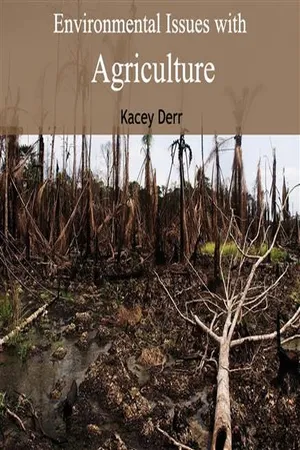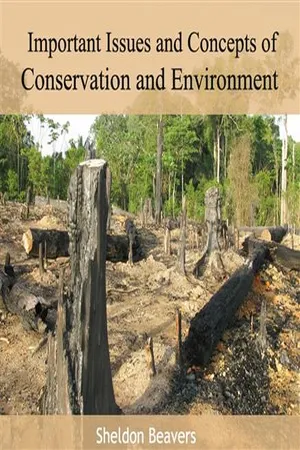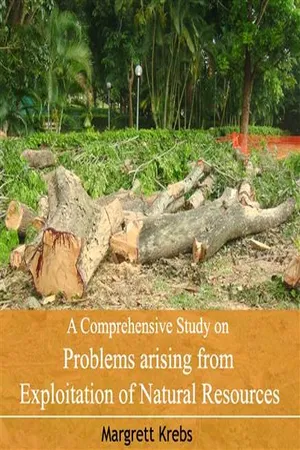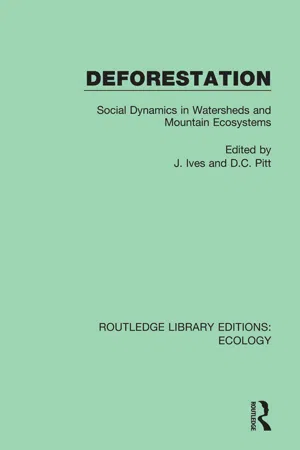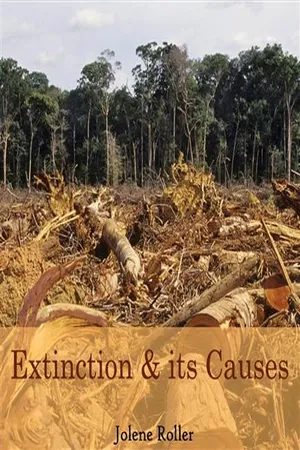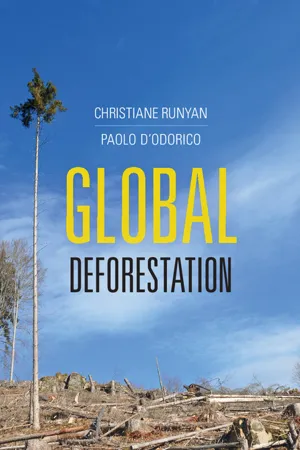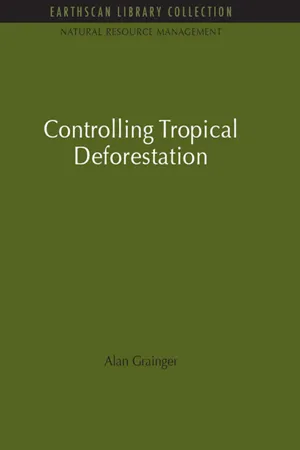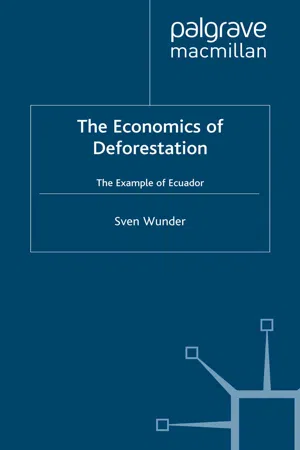Geography
Deforestation
Deforestation refers to the large-scale clearing of forests, primarily for agricultural or commercial purposes. This process leads to the permanent removal of trees and vegetation, resulting in significant environmental impacts such as loss of biodiversity, disruption of ecosystems, and contribution to climate change. Deforestation is a pressing global issue with far-reaching consequences for both the environment and human societies.
Written by Perlego with AI-assistance
Related key terms
1 of 5
11 Key excerpts on "Deforestation"
- eBook - PDF
Environment
An Interdisciplinary Anthology
- Eugene Jolas, Andreas Kramer, Rainer Rumold(Authors)
- 2008(Publication Date)
- Yale University Press(Publisher)
6 Deforestation The world’s forests and native grasslands are vital to human life and the planet’s ecological well-being. In addition to providing material for housing, paper, and fuel, forests serve as CO 2 sinks, recreation areas, and habitat for countless species of birds, other animals, and plants. Our economic prosperity and our psychological health, as well as the biodiversity of the planet, rest on the preservation, good management, and sustainability of the Earth’s woodlands. Michael Williams and George M. Woodwell illustrate the current state of the world’s forests, in a North American and global context respectively: a prospect that is encouraging in some respects but discouraging in most others. Whether one defines Deforestation as the wholesale destruction of extensive woodland areas or as the pursuit of selective but ecologically unsound logging practices, its devastating effects are clear. William Dietrich’s “The Cutter” demonstrates that the local impact of even one act of clear-cutting in a forest is tremendous, in its effects on plant and animal species, but also with regard to soil, water retention, microclimate, and the like. These results in turn directly and indirectly influence the human community within or near the forest. On a different scale, Thomas Rudel and Bruce Horowitz’s Tropical Deforestation gives evidence of the broader problems of regional or continental Deforestation, par-ticularly with the logging techniques used in much of the industrializing world. Here too, often disastrous ecological consequences arise from and further exac-erbate the greed, financial need, social inequality, and communal tension that characterize the societies in which forests are located. Yet observers resist recognizing the obvious, principally because historical, ideological, economic, ethnocentric, and even gender assumptions shape how forests and Deforestation are perceived. - No longer available |Learn more
- (Author)
- 2014(Publication Date)
- University Publications(Publisher)
The removal of trees without sufficient reforestation has resulted in damage to habitat, biodiversity loss and aridity. It has adverse impacts on ________________________ WORLD TECHNOLOGIES ________________________ biosequestration of atmospheric carbon dioxide. Deforested regions typically incur significant adverse soil erosion and frequently degrade into wasteland. Disregard or ignorance of intrinsic value, lack of ascribed value, lax forest management and deficient environmental laws are some of the factors that allow Deforestation to occur on a large scale. In many countries, Deforestation is an ongoing issue that is causing extinction, changes to climatic conditions, desertification, and displacement of indi-genous people. Among countries with a per capita GDP of at least US$4,600, net Deforestation rates have ceased to increase. Causes There are many causes of contemporary Deforestation, including corruption of government institutions, the inequitable distribution of wealth and power, population growth and overpopulation, and urbanization. Globalization is often viewed as another root cause of Deforestation, though there are cases in which the impacts of globalization (new flows of labor, capital, commodities, and ideas) have promoted localized forest recovery. In 2000 the United Nations Food and Agriculture Organization (FAO) found that the role of population dynamics in a local setting may vary from decisive to negligible, and that Deforestation can result from a combination of population pressure and stagnating economic, social and technological conditions. According to the United Nations Framework Convention on Climate Change (UNFCCC) secretariat, the overwhelming direct cause of Deforestation is agriculture. Subsistence farming is responsible for 48% of Deforestation; commercial agriculture is responsible for 32% of Deforestation; logging is responsible for 14% of Deforestation and fuel wood removals make up 5% of Deforestation. - No longer available |Learn more
- (Author)
- 2014(Publication Date)
- Library Press(Publisher)
The removal of trees without sufficient reforestation has resulted in damage to habitat, biodiversity loss and aridity. It has adverse impacts on ____________________ WORLD TECHNOLOGIES ____________________ biosequestration of atmospheric carbon dioxide. Deforested regions typically incur significant adverse soil erosion and frequently degrade into wasteland. Disregard or ignorance of intrinsic value, lack of ascribed value, lax forest management and deficient environmental laws are some of the factors that allow Deforestation to occur on a large scale. In many countries, Deforestation, both naturally occurring and human induced, is an ongoing issue. Deforestation causes extinction, changes to climatic conditions, desertification, and displacement of populations as observed by current conditions and in the past through the fossil record. Among countries with a per capita GDP of at least US$4,600, net Deforestation rates have ceased to increase. Causes There are many causes of contemporary Deforestation, including corruption of government institutions, the inequitable distribution of wealth and power, population growth and overpopulation, and urbanization. Globalization is often viewed as another root cause of Deforestation, though there are cases in which the impacts of globalization (new flows of labor, capital, commodities, and ideas) have promoted localized forest recovery. In 2000 the United Nations Food and Agriculture Organization (FAO) found that the role of population dynamics in a local setting may vary from decisive to negligible, and that Deforestation can result from a combination of population pressure and stagnating economic, social and technological conditions. According to the United Nations Framework Convention on Climate Change (UNFCCC) secretariat, the overwhelming direct cause of Deforestation is agriculture. - No longer available |Learn more
- (Author)
- 2014(Publication Date)
- University Publications(Publisher)
The removal of trees without sufficient reforestation has resulted in damage to habitat, biodiversity loss and aridity. It has adverse impacts on ________________________ WORLD TECHNOLOGIES ________________________ biosequestration of atmospheric carbon dioxide. Deforested regions typically incur significant adverse soil erosion and frequently degrade into wasteland. Disregard or ignorance of intrinsic value, lack of ascribed value, lax forest management and deficient environmental laws are some of the factors that allow Deforestation to occur on a large scale. In many countries, Deforestation, both naturally occurring and human induced, is an ongoing issue. Deforestation causes extinction, changes to climatic conditions, desertification, and displacement of populations as observed by current conditions and in the past through the fossil record. Among countries with a per capita GDP of at least US$4,600, net Deforestation rates have ceased to increase. Causes There are many causes of contemporary Deforestation, including corruption of government institutions, the inequitable distribution of wealth and power, population growth and overpopulation, and urbanization. Globalization is often viewed as another root cause of Deforestation, though there are cases in which the impacts of globalization (new flows of labor, capital, commodities, and ideas) have promoted localized forest recovery. In 2000 the United Nations Food and Agriculture Organization (FAO) found that the role of population dynamics in a local setting may vary from decisive to negligible, and that Deforestation can result from a combination of population pressure and stagnating economic, social and technological conditions. According to the United Nations Framework Convention on Climate Change (UNFCCC) secretariat, the overwhelming direct cause of Deforestation is agriculture. - No longer available |Learn more
- (Author)
- 2014(Publication Date)
- University Publications(Publisher)
The removal of trees without sufficient reforestation has resulted in damage to habitat, biodiversity loss and aridity. It has adverse impacts on ________________________ WORLD TECHNOLOGIES ________________________ biosequestration of atmospheric carbon dioxide. Deforested regions typically incur significant adverse soil erosion and frequently degrade into wasteland. Disregard or ignorance of intrinsic value, lack of ascribed value, lax forest management and deficient environmental laws are some of the factors that allow Deforestation to occur on a large scale. In many countries, Deforestation, both naturally occurring and human induced, is an ongoing issue. Deforestation causes extinction, changes to climatic conditions, desertification, and displacement of populations as observed by current conditions and in the past through the fossil record. Among countries with a per capita GDP of at least US$4,600, net Deforestation rates have ceased to increase. Causes There are many causes of contemporary Deforestation, including corruption of govern-ment institutions, the inequitable distribution of wealth and power, population growth and overpopulation, and urbanization. Globalization is often viewed as another root cause of Deforestation, though there are cases in which the impacts of globalization (new flows of labor, capital, commodities, and ideas) have promoted localized forest recovery. In 2000 the United Nations Food and Agriculture Organization (FAO) found that the role of population dynamics in a local setting may vary from decisive to negligible, and that Deforestation can result from a combination of population pressure and stagnating economic, social and technological conditions. According to the United Nations Framework Convention on Climate Change (UNFCCC) secretariat, the overwhelming direct cause of Deforestation is agriculture. - eBook - ePub
Deforestation
Social Dynamics in Watersheds and Mountain Ecosystems
- J. Ives, D.C. Pitt(Authors)
- 2019(Publication Date)
- Routledge(Publisher)
3Soil and Water Impacts of Deforestation *L.S. Hamilton and A.J. Pearce* A version of this paper was originally presented to the 16th Pacific Science Congress, Seoul, Korea, August 1987At the outset, we wish to set forth an important semantic ground rule concerning the harvesting of forest products. This activity has frequently been called ‘Deforestation’ in the press and indeed in some technical writing. It is our contention that use of the term ‘Deforestation’ must be discontinued, if scientists, forest land managers, government planners and environmentalists are to have meaningful dialogue on the various human activities that affect forests, and the biophysical consequences of those actions.The generic term ‘Deforestation’ is used so ambiguously that it is virtually meaningless as a description of land-use change. It has been used at times to refer to any or all of the following activities with respect to existing forest: fuelwood cutting; commercial logging, shifting cultivation; forest clearing for conversion to continuous annual cropping, to grazing, to food, beverage or industrial tree crops, to forest plantations; and finally where burning has produced a degraded forest. (Bowonder (1982) in an article ‘Deforestation in India’ includes these and a host of other activities such as: gathering medicinal plants, killing of wildlife, and flooding by reservoirs.) Though each of these activities will have different hydrological and erosional effects, they are too often undifferentiated, and one reads or hears generalizations that Deforestation results in erosion, in floods, in droughts, in accelerated reservoir sedimentation, in drying up of wells and springs, in desertification, and in nutrient impoverishment of the area. - No longer available |Learn more
- (Author)
- 2014(Publication Date)
- Learning Press(Publisher)
______________________________ WORLD TECHNOLOGIES ______________________________ Chapter 5 Deforestation Jungle burned for agriculture in southern Mexico ______________________________ WORLD TECHNOLOGIES ______________________________ Deforestation in the Gran Chaco, Paraguay ______________________________ WORLD TECHNOLOGIES ______________________________ Deforestation and increased road-building in the Amazon Rainforest are a significant concern because of increased human encroachment upon wild areas, increased resource extraction and further threats to biodiversity. Deforestation is the clearance of forests by logging and/or burning (popularly known as slash and burn). Deforestation occurs for many reasons: trees or derived charcoal are used as, or sold, for fuel or as lumber, while cleared land is used as pasture for livestock, plantations of commodities, and settlements. The removal of trees without sufficient reforestation has resulted in damage to habitat, biodiversity loss and aridity. It has adverse impacts on biosequestration of atmospheric carbon dioxide. Deforested regions typically incur significant adverse soil erosion and frequently degrade into wasteland. Disregard or ignorance of intrinsic value, lack of ascribed value, lax forest management and deficient environmental laws are some of the factors that allow Deforestation to occur on a large scale. In many countries, Deforestation is an ongoing issue that is causing extinction, changes to climatic conditions, desertification, and displacement of indigenous people. ______________________________ WORLD TECHNOLOGIES ______________________________ Among countries with a per capita GDP of at least US$4,600, net Deforestation rates have ceased to increase. Causes There are many causes of contemporary Deforestation, including corruption of government institutions, the inequitable distribution of wealth and power, population growth and over-population, and urbanization. - eBook - PDF
- Christiane Runyan, Paolo D'Odorico(Authors)
- 2016(Publication Date)
- Cambridge University Press(Publisher)
Steep land slope is another environmen- tal factor that has been cited as leading to reduced Deforestation rates (e.g., Rolett and Diambond, 2004; Mas et al., 1996). Rolett and Diamond (2004) suggest that Economic Impacts and Drivers 163 agriculture (hence land clearance) decreases with elevation because of low tempera- tures that may be unfavorable for crops, steep slopes, and difficult access. Apart from environmental characteristics of the forest, ecological attributes such as the presence of a positive feedback can affect the value of the standing forest and, thus, poten- tially make forest conservation more economically attractive. For instance, Runyan et al. (2015) coupled a biophysical model accounting for a positive feedback with an economic model and found that the optimal quantity of vegetation was considerably greater when the forest exhibited a positive feedback. While environmental variables alone cannot be used as predictors of Deforestation rates, they may influence an area’s susceptibility to Deforestation. 5.4 Modeling Frameworks to Examine Deforestation There are three primary spatial scales of economic modeling frameworks that are used to examine Deforestation: microeconomic, regional, and macroeconomic. The decisions made by Deforestation agents about how much and when to deforest are influenced by immediate and underlying causes (Angelsen and Kaimowitz, 1999). Immediate causes driving Deforestation are characteristics such as background, preferences, and resources and decision parameters based on microeconomic fac- tors such as prices, technology, institutions, new information, and access to services and infrastructure. Underlying macrocauses of Deforestation influencing the agents’ characteristics and decision parameters are the market, the dissemination of new technologies and information, the development of infrastructure, and institutional factors such as the property regime (Angelsen and Kaimowitz, 1999). - eBook - ePub
Forest Politics
The Evolution of International Cooperation
- David Humphreys(Author)
- 2014(Publication Date)
- Routledge(Publisher)
This is due in large measure to NGO pressure. Indeed, the World Rainforest Movement has published on this subject with the specific intention of bringing the issue of agrarian reform into international debate. 92 Natural phenomena A final cause of Deforestation is natural disasters such as storms, hurricanes and drought. Such factors lie beyond direct human control. However, it should be noted that the question arises to what extent such phenomena are, to some extent at least, human made as the result of, for example, altered landscapes and climate change. Concluding remarks The objective of this section has been to argue that not only do the forces of Deforestation lie outside the forest, but that they are frequently transnational in nature. In the final section of this chapter it will be argued that finding a solution to the causes of Deforestation is a problem that cannot be considered in isolation from other factors; it is linked to two other problems, namely the need to devise new institutions and the need to arrive at a new notion of forest proprietorship. THE EFFECTS OF Deforestation Global warming The effects of Deforestation range from the global to the local level. One of the most important ramifications of Deforestation is its effect on the degradation of a global common, namely the atmosphere. Deforestation contributes to global warming, which occurs from increased atmospheric concentrations of greenhouse gases leading to net increases in the global mean temperature. The atmospheric process by which greenhouse gases contribute to temperature increases is known as radiative forcing. There are four principal greenhouse gases, namely carbon dioxide (CO 2), methane (CH 4), nitrous oxide (N 2 O) and chlorofluorocarbons (CFCs). The effects of global warming are potentially calamitous - eBook - ePub
- Alan Grainger(Author)
- 2013(Publication Date)
- Routledge(Publisher)
Tropical Deforestation is having, and will continue to have, significant environmental impacts. Biological diversity is being reduced by Deforestation and logging, with effects ranging from an erosion of the genetic diversity of some species to the extinction of others. The tragedy of extinction is that we lose some species before we even know they existed. Less extreme impacts may prejudice our ability to breed new varieties of crops to cope with new pests and diseases. The high concentration of species (half of the world total) in the tropical rain forests is one of the greatest justifications for conserving them.Deforestation and logging are also causing soil degradation, changes in water flows and increased sedimentation of rivers, reservoirs and irrigation systems. The scale of these impacts can be significantly reduced by better forest management, choosing the land uses introduced to particular sites more carefully, and being firm in protecting catchment forests from clearance and intensive logging.Table 6.3. Alternative scenarios for a carbonforest programmeA. Afforestation scenarios for a carbonforest to achieve a range of reductions in annual atmospheric carbon dioxide increment over periods of 10, 20, 30 and 50 years.B. Integrated afforestation and Deforestation-control strategies. Net carbon emissions resulting from the combination of carbon emissions by all tropical Deforestation (High and Low scenarios) and carbon uptake by the carbonforest (various planting rate scenarios)NB. The net carbon uptake by the 7.1 million ha of existing tropical industrial wood plantations in 1980 adds an estimated 0.034 gt per annum to the above.Source: Grainger (1990c)Tropical Deforestation is recognized as making a major contribution to potential global climate change resulting from the enhanced greenhouse effect, though there is less certainty about its possible impact on local and regional climates. Tropical countries will suffer from future climate change just as much as temperate countries but the role of tropical rain forest as a global carbon sink and store is so important that as part of a future global initiative to mitigate climate change they could receive substantial financial aid to protect their forests and increase the rate of tropical reforestation. However, the scale of such action will be limited by the same social, economic and political constraints that keep the present planting rate in the whole tropics down to only 1 million ha per annum. - eBook - PDF
Economics of Deforestation
The Example of Ecuador
- Sven Wunder(Author)
- 2000(Publication Date)
- Palgrave Macmillan(Publisher)
Based on recent archaeological research, there is some evidence that Deforestation was followed by over-exploitation of soils already in pre- Columbian times. The classical example is Mayan urbanism, which reached its peak in the centuries up to AD 800, but then seemed to have experienced a decline that, at least in part, was determined by ecological factors. Although the Mayas initially settled near the most fertile soils available, these soils were also extremely vulnerable to ero- sion once forest cover had been removed; about 75 per cent of the Yucata Ân Peninsula's forests were modified to some extent (McNeely 1993: 9). With growing population and an increasing demand for agri- cultural surpluses to maintain an advanced and demanding state appar- atus, it seems that agriculture was both intensified to excess, and extended to more marginal hillside areas of even greater erosion risk. Reduced soil fertility hampered agriculture and food production, which Latin American Patterns of Deforestation 63 is supposed to have lead to out-migration and a decrease in population. There is evidence that nutritional standards declined, causing disease, and growing conflicts between the various city states may have been fuelled by food shortages (Ponting 1992: 92±6). With the collapse of the Mayan civilizations, the abandoned forests of Yucata Ân reached a gradual but complete recovery over the next 500 years, until the arrival of the Spaniards in 1492. The very nature of these historical analyses implies that the evidence is hard to come by, which obviously leaves room for specific debates. Notably, Graham and Pendergast (1992) deduce from archaeological studies in Belize that local Mayan forest clearing and soil degradation did occur, but only on a small, local scale. Clearing was a ritual process in which the felling of selected species was prohibited, both for their religious functions and for certain essential use values; thus the land was not entirely denuded.
Index pages curate the most relevant extracts from our library of academic textbooks. They’ve been created using an in-house natural language model (NLM), each adding context and meaning to key research topics.

